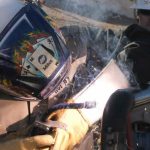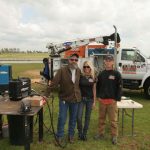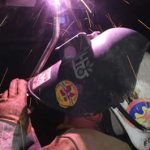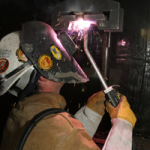MIG Welding with a Bernard Q-Gun MIG Gun
Contractor Bob Jolson talks about how Bernard’s Q-Gun™ semi-automatic air-cooled MIG gun has increased his productivity and reduced his back pain while welding large diameter pipe.
Jolson Welding (Wheatland, Calif.) relies on the durability and comfort of the Bernard® Dura-Flux™ self-shielded flux-cored gun for its tough structural, pile and pipe welding projects. Learn how the features of this gun help them get the job done.
Self-shielded flux-cored arc welding (FCAW-S) offers numerous benefits, including good weldability, high deposition rates, and excellent chemical and mechanical properties. These make the process a common choice for many applications, such as structural steel erection, bridge construction and heavy equipment repair. But like any welding process, it is not without its challenges. There are a few simple tips and best practices that can help address these challenges. Using this knowledge — with a bit of practice — can save time, money and frustration, and help achieve high weld quality. Slag inclusions — the result of molten flux from inside the welding wire becoming trapped inside the weld — can commonly occur in out-of-position and multi-pass FCAW-S applications. Preventing this issue depends on following key best practices and utilizing proper welding techniques. These include: Porosity is a common weld defect that occurs when gas is trapped in the weld. Cleaning the base material thoroughly prior to welding is the main way to prevent this problem. Remove all dirt, rust, grease, oil, paint, moisture and other contaminants from the full length of the weld joint. While welding, be sure to maintain wire stick-out of no more than 1 1/4 inch beyond the contact tip. In addition, using filler metals containing added deoxidizers can help prevent porosity and allow for welding through light contaminants. However, these wires are not a replacement for proper cleaning. Another defect, wormtracking, refers to marks on the surface of the weld bead caused by gas that the flux inside the wire creates. Take care to avoid excessive voltage for the wire feed setting to help prevent this problem. In situations where wormtracking occurs, reduce the voltage in increments of 1/2 volt until the problem stops. Undercutting and lack of fusion Lack of fusion occurs when the weld metal does not properly fuse with the base material or with the preceding weld bead during multi-pass welding. Using an improper gun angle is the main cause of this problem. Maintain heat input and correct work angle of the gun to help prevent lack of fusion. Use a gun angle drag of 15 to 45 degrees, and keep the arc on the trailing edge of the welding puddle. When using a weaving technique, hold the arc on the groove’s sidewall. A dirty work surface is another common cause of lack of fusion. Proper and thorough cleaning of the surface before welding and in between passes is recommended. Undercutting causes a weaker area at the toe of the weld by allowing a groove to melt in the base metal that is not filled in by the weld metal. This defect can often lead to cracking. To prevent undercutting, follow welding parameters for the appropriate welding current and voltage. Gun angle also plays a key role in this issue. In addition, be sure to maintain a travel speed that allows the weld metal to fill the melted-out areas of the base material completely. When it comes to weld joint penetration, too much and too little are both problematic. Good joint penetration is critical to completing high-quality welds, so it’s important to pay attention to how much weld metal is going into the joint. When weld metal melts through the base metal and hangs underneath the weld, this is excessive penetration. It is most often caused by too much heat. Avoid this problem by maintaining proper heat input for the application. Lower the voltage range, reduce wire feed speed and increase travel speed. When the problem is a lack of penetration — or a shallow fusion between the weld and base metals — taking the opposite steps will help: increase the voltage range and wire feed speed, while reducing travel speed. Joint preparation also plays a role in proper penetration. To maintain the right wire extension and obtain necessary arc characteristics for good weld quality, it is imperative to access the bottom of the groove. As with any welding process, FCAW-S can present some challenges. By utilizing proper welding technique and taking steps to address the issues, it will be easier to identify and solve problems quickly — or even prevent them from occurring — in order to reap the productivity and quality benefits the process offers.
Jolson Welding deals in heavy steel. The company specializes in structural welding for bridge and highway work in one of the most seismically sensitive areas in the world: Northern California. Working with the state department of transportation and local contractors, Bob Jolson (owner, operator, welder) and his team have established welding processes that meet strict code requirements (CalTrans, AWS D1.8 and D1.5), and pass ultrasonic and x-ray tests without fail. A recent job welding soldier pile highlighted the soup-to-nuts mobile welding system that Jolson has built for these applications. A soldier pile is a critical component of many highway projects in Northern California as soil makeup and varying terrain make earth retention necessary. On this particular project, beams of A709 bridge steel will be paired together and placed into holes drilled deep into the ground, serving as the structural backbone for a rebar and concrete retaining wall. Flux-cored arc welding (FCAW) is Jolson’s process of choice. There are structural steel welders who still rely on the shielded metal arc welding (SMAW, or Stick) process due to familiarity; however, flux-cored welding offers a number of advantages in terms of quality and productivity. “If you don’t want to get a lot done in a hurry, stick welding is the way to go,” says Jolson, “but running this process (flux-cored), the deposition rate is really high on it and you get a lot done in a day – probably five or six times more than you would with stick.” Engine-driven welder generator: Big Blue® 500 Voltage-sensing wire feeder: SuitCase® X-TREME™ 12VS Remote control: Wireless Remote Hand Controls Self-shielded flux-cored wire: Hobart Brothers Fabshield® XLR-8™ Self-shielded flux-cored welding gun: Bernard™ Dura-Flux™ Gun 1. Greater productivity through faster deposition rates — the .072-inch self-shielded flux-cored wire used in this application compared to a 7018 1/8-inch stick electrode provides approximately a 249-percent increase in deposition rate in the flat and horizontal positions, and a 162-percent increase in vertical up and overhead positions. 2. Greater deposition efficiency compared to stick electrodes — the flux-cored wire discussed in this case presents a 75-83 percent deposition efficiency versus 65-73 percent in a comparable 7018 stick electrode. 3. Low hydrogen weld deposit (provides resistance to cracking, promotes X-ray quality welds) — the wire used in this application features less than 8 ml/100g of diffusible hydrogen. 4. Welds out of position at high currents, also helping with productivity. 5. Less cleanup through simplified slag removal. Jolson’s power source preference is large-frame, low-speed diesel engine-driven welder generators. Jolson operates a number of Miller welder/generators, including the BigBlue 500. The Big Blue 500 is a CC/CV power source – necessary for flux cored welding – that provides 14-40 volts of welding output in MIG and flux-cored processes. “Our outputs will depend on what positions we’re welding in” says Jolson. “In flat positions we’ll run up around 23 volts and 300 inches per minute (ipm), and when welding vertical-up we run about 230, 240 ipm at about 22 volts.” In addition to providing adequate weld output, Jolson chose this welder/generator for its ability to work at low RPM. “We run the Big Blue engine drives because they run at 1,850 RPM, which helps us keep our fuel economy in check,” says Jolson. “I can get 35 to 40 hours of welding out of one tank of fuel.” Jolson also runs deluxe models that provide 20,000 watts 3-phase power and 12,000 watts 1-phase power in addition to the machine’s standard power. This gives them the ability to run common jobsite tools and accessories, as well as equipment with 3-phase input requirements such as pumps, plasma cutters and portable welders that help turn one machine into a multi-arc work station. “There have been a lot of times where we’re out on a pipeline job and we’ll have to plug in a three-phase pump to empty our ditch and be able to get down in there and do our welding,” says Jolson. “We also use that three-phase power to run our plasma cutters. They cut a lot quicker and everything stays nice and cool, as the duty cycle is increased (with the 3-phase power input power).” To give you an idea of how much welding goes into these structural projects, Jolson and colleague Brandon Hobbs burn through 40 to 45 pounds of wire each day, per man. To simplify inventory and handling, Jolson has standardized almost his entire structural operation on .072-inch Fabshield XLR-8 self-shielded flux-cored wire (AWS E71T-8JD H8). “We stick with the .072 because we could turn it way up or way down, we could weld anything from a handrail to a four-inch thick piece of pipe,” says Jolson. “One wire does it all. And it’s user-friendly. It’s not finicky. You could be a few volts off, or off on your ipm, and it still welds (to standards). ” The primary benefit of a flux-cored wire over a stick electrode is that it is continuously fed, whereas a stick electrode requires the worker to continuously start and stop to replace electrodes. This improves productivity and minimizes the possibility of defects caused by more frequent starts and stops. There is also a higher percentage of lost material with stick electrodes as filler metal in the stub is discarded. As such, 50 pounds of flux-cored wire compared to 50 pounds of stick electrodes would yield a higher deposition efficiency: more of the filler metal is actually deposited into the joint. That efficiency ranges from 75-83 percent with this particular wire compared to 65-73 percent with a 7018 stick electrode (when the product has been burned to a 2-inch stub). “It’s a real high deposition welding wire, and it’s very clean,” says Jolson. “Very seldom do you have any slag inclusions or porosity or anything like that.” The cleanliness Jolson refers to is due in part to easy slag removal. The slag produced by this wire is known to be self-peeling in many cases, improving productivity through less cleaning and helping to prevent potential defects caused by slag inclusions. It also features low levels of diffusible hydrogen (less than 8 mL/100g) and excellent mechanical properties for welding in seismic zones: 58 ksi minimum yield strength, 70 ksi minimum tensile strength, with 22 percent minimum elongation at 2 inches, and impact values of 40 ftlbs at 70 degrees Fahrenheit. “It has really great Charpy V-Notch impact values, and that’s important because of the critical work we do,” says Jolson. One of the concerns that face Flux-Cored welding applications in the field is the consistency of the wire feeding itself. Wire feed speed consistency is important in terms of controlling the deposition rate and heat input into the steel beam – voltage varies with the changing distance between the electrode and the work piece. The new Miller SuitCase X-TREME 12VS voltage-sensing wire feeder ensures wire feed consistency through new robust features and a design resilient to temperature swings throughout the day known to cause variations in feeder performance. “The new feeder is the smoothest feeder I’ve ever ran,” says Jolson. “They have a little bit bigger motor in them, so they don’t get hot throughout the day. (With other feeders), the weather gets hotter and the motor gets hotter in the feeder. The new 12VS is very constant and doesn’t change around. Wherever you put it in the morning, it’s there at the end of the day. There’s no variation.” The new feeder features a new drive motor assembly, motor control and integrated tachometer that provides electronic wire feed speed control and accuracy that rivals the performance of bench-top-style feeders found in shop environments. A new wire delivery system makes it easier to load the 12-inch wire spools and reduces drag on the wire by eliminating the inlet guide and allowing the wire to roll over the large radius of the drive rolls. It also features a new visual scale on the wire pressure knob that eliminates guesswork and allows welders to specifically dial in tension to settings they know provide the best feeding performance for the size and type of wire they are working with. “Having the register on the scale is nice because you always know where you need to be,” says Jolson. “If somebody messes with your machine or puts different wire in it, you just dial it in and you’re up and running. You don’t have to guess and turn it a half-turn and back a half-turn. It makes it really user friendly.” Jolson also claims the feeders allow him to more easily load in new spools of wire, and switch between different wire types/diameters through the elimination of guide tubes within the feeder. “In the old days, we had to change out guide tubes (when changing wire diameters),” he says. “There is no guide tube on this feeder. You just open your feeder, feed your wire through right into the gun, cinch her down and you’re ready to go.” A focus of welding manufacturers has been to put as much knowledge and power into the hands of the welder at the point-of-use as possible. In an application like this, that includes the ability to know exactly what your machine settings are and to change them without having to go back to the welder/generator at the truck. Two technologies that help Jolson with this are digital meters on the wire feeder and wireless remote control technology matched up with the welder/generator. Together, these technologies help improve productivity by allowing welders to more quickly dial in their equipment and get to work faster. “The (wire feeders) without the digital meters, you have to call over to your buddy to tell you where the needle is bouncing around at, and you’re never really accurate that way,” says Jolson. “With this feeder, you can make a practice pass, let off the trigger and look over (at the feeder) and it will hold its values. That way you know where you’re at and you don’t have to bother your partner to come and help you. You can really see them good, too, out in the sun. It’s got some special technology in there that, even out on a sunny day, you can still see your numbers – and that’s nice.” With a voltage sensing wire feeder and CV power source, voltage is set at the power source while wire feed speed (amperage) is set at the feeder. In the past, after running his test pass, Jolson would have to get up and go back to the truck to adjust his voltage. Now, with wireless remote technology, Jolson has full control of that setting without leaving his workplace. “If I’m up on a ladder and I’ve got to change my settings, I don’t want to crawl up and down all day,” says Jolson. “If I’m down in a ditch and I’ve got to turn the machine up and down, rather than spending ten minutes crawling in and out of there, I can turn it up or down and I’m good to go.” Rounding out Jolson’s structural welding system is the Bernard Dura-Flux Self-Shielded Flux-Cored Gun, built specifically for self-shielded flux-cored welding. Rated at 350 amps, these guns feature ergonomic handles, easy-change consumables and a “We like the long goosenecks because it keeps us away from the heat,” says Jolson. “And this sealed microswitch, If you’re out in a dusty environment where it’s laying on the ground all the time, it never gets any dirt or dust in it and it continues to work perfect every time.” “I like the Bernard gun – how you hold it in your hands,” says Hobbs. “You don’t have any fingers that are pressed together, squeezing together, pinching themselves off, getting all tingly and numb. It’s easy to hold and move around. It’s comfortable in the grip of your hand and the trigger guard isn’t too bulky – it does its job without messing you up, without hindering your performance.” Jolson also likes the ability to change out the contact tip without tools – a technology that Bernard calls its Centerfire™ Consumable System. “You take off the little retainer, the tip comes out and you replace your tip,” says Jolson. “And, normally, the tip always wears the top and the bottom, it wears a groove in it. (With these) you can loosen this up, turn the tip 90 degrees, tighten it back down and you’ve got a brand new tip again – so you get two lives out of one tip.” When put together, these varied components build a structural steel welding system that Jolson finds to be optimal for the work he does, ranging from bridge construction to pile splicing. Knowing that all of these components are designed by companies that work together to provide best-in-class, market-focused solutions, Jolson has peace of mind that he’s going to work with the best tools available. “It’s nice because everyone seems to work together,” says Jolson. “If I have a problem with my wire and I’m talking to a Miller representative, they can help me out and vice versa. With Miller, Bernard and Hobart Brothers working together, it really helps us out as end users because everybody knows a little about everything. There’s always somebody there to help you out.”
Measuring the value of a welding gun can be difficult when the gun is working properly. It’s those times when the gun is malfunctioning and you’re losing valuable production time trying to clear out a bird’s nest, change your fifth contact tip of the day or repair a shorted out power cable that the importance of the welding gun becomes clear. As one of Arizona’s premier handrail fabricators, Hot Az Hell Welding and Fabrication learned first hand the value of a welding gun when they began upgrading the majority of their equipment from Stick to the flux-cored process. While upgrading, company president Shawn Moreland didn’t think much about the flux-cored gun he would purchase and made his decision strictly based on price. Then, he and superintendent Chris Rice worked side-by-side on a project while Rice used a Bernard Dura-Flux™ gun instead. “I would be getting birds nests several times a day with the gun I purchased, and each time it would happen, Chris would have to come over and fix it for me,” Moreland recalls. “It would take him off his work and up to 10 minutes to fix. That whole week Chris didn’t have a single birds nest with the Dura-Flux, and eventually we realized it was the gun that made the difference.” They outfitted Moreland’s wire feeder with a Dura-Flux and he didn’t experience a single bird’s nest for the rest of the job. “We just threw the other gun away,” Moreland said. “After I got a chance to use Chris’ gun, I was 100 percent sold on Bernard.” As pleased as they were with the lack of downtime from repairing birds nests, Rice and Moreland have been even more impressed with the gun’s durability. “It gets pretty hot here, and the last thing my guys want to worry about is babying their welding equipment, so we end up putting the guns through some serious abuse,” Moreland explained. “I know you’re not supposed to, but we use the guns to drag our feeders all over a job site and the fact that they’re still working really tells me something about the quality of the gun.” Quality is something that Moreland, Rice and the other three Hot Az Hell employees, know a lot about. In over 20,000 linear feet of hand rail fabrication, they can boast that they have not had to make a single repair. “We have a flawless record with the register of contractors,” Moreland said. “We have dozens of general contractors that recommend us for federal, state, local and even residential projects, and we owe a lot of that to Chris’ commitment to high-quality welding.” The company specializes in hand rail fabrication, but also takes on a wide variety of welding jobs, including a recent project in which they welded five railroad cars together to form a bridge over the Central Arizona Project (CAP) Canal. Given the company’s history, it’s no surprise that an exceptional welding track record grew out of exceptional personal chemistry between Moreland and Rice. The two men became best friends while working as first line supervising foremen at an Arizona gas utility. “We formed a really tight bond back then because we were the only two that we could rely on within the company,” Moreland recalls. Both Moreland and Rice left their jobs to start their own businesses within a year of each other. Moreland said he frequently attempted cajoling Rice into working for him, and finally in 2006 Rice acquiesced and closed his business in order to join Hot Az Hell. From modest beginnings in 2006, Hot Az Hell has grown from an annual gross $160,000 their first year to projections of over $800,000 in 2009 — all with a five person staff. As of early 2009, the company was booked solid through mid-2010 with contracts to install over 32,000 linear feet of hand rail, including two of the largest projects in the Arizona Department of Transportation’s history — the widening of U.S. Highway 60 in Mesa and the Hoover Dam Kingman Highway expansion project. Moreland said the friendship among his employees, and their willingness and ability to take on virtually any of the work the company performs is a major contributor to their success. “We’re a very tight knit group. We’re more like a family than a company, but we also understand the business aspect of it as well,” Moreland said. “With a company our size, especially with the economy in a recession, everyone needs to be very versatile and able to take on whatever tasks the job demands.” Another key to the company’s success is Moreland’s confidence in the fabrication and welding expertise of Rice, the company’s ‘MacGyver.’ For his part, Rice said he is continually on the lookout for products and technologies that increase the company’s productivity and operator efficiency. As an example, during the recent CAP Canal project, the company was told they would need to use 7018 stick electrodes to weld the rail cars together, but after the first day of welding the pan decking using the stick electrodes, Rice asked the project inspector if they could use a structural flux-cored wire. They were allowed to use the flux-cored wire, and the following day, they produced four-times the welds of another crew member who was still using the 7018 rods. “They were losing several thousand dollars an hour every day that they couldn’t get their cranes across a 22-foot diameter pipe,” Moreland recalls. “By the end of the project, the general contractor told us, ‘We owe you guys big time.’ They didn’t think there was any way that we were going to be able to finish the bridge in the time that it took us.” Rice and Moreland apply that same focus on productivity and efficiency to purchasing their flux-cored guns. For them, a great welding gun doesn’t so much speed up production as it avoids becoming an obstacle to production. That means minimizing downtime associated with contact tip changeovers, reducing operator fatigue and providing smooth and consistent wire feeding while enduring large amounts of mechanical and heat stress. The majority of the hand rails they weld are two-inch, schedule 40 mild steel pipe. Rice said for the .045-in. flux-cored wire he uses he sets his welding generator at 25 volts and about 110 inches per minute wire feed speed. They use a voltage-sensing wire feeder that provides the ability to work up to 400 feet from the welding generator (compared to roughly 75 feet with a remote control wire feeder). Given the heat and abuse that flux-cored guns are exposed to in normal environments, to say nothing of the brutal Arizona desert heat and landscape, finding one that simply allows them to keep welding is no easy task. Once they put the Dura-Flux gun to the test, however, they knew their search had ended. “We were on a job in Wickenburg (Az.) this week, and it was about 100 degrees out and we were working on a steep, 50-foot tall embankment,” Rice said. “After working all day in that heat, we were dragging our feeder by the gun up hill through rocks and dirt, and that’s pretty much what we’ve been putting the gun through on a regular basis. So far, there have been no problems with the gun or the consumables.” Moreland echoed that sentiment, recalling a recent bridge job. “There was only about four feet of clearance, so you had to hunch over and drag your machine every time you finished a weld and needed to move,” Moreland said. “When you’re hot and tired and working your butt off, you’re not going to be too careful with your equipment. These guns have been used hard and they’re still going strong.” One of the features of the Dura-Flux that allows it to endure the abuse to which Rice and Moreland subject it is an industrial-quality strain relief on the back end of the power cable. The high-tension strain relief protects the sensitive parts of the cable—where it connects to the gun and the power pin—from severe bends that could damage or fray the copper wiring in the cable or create a kink in the liner. Another key factor in maintaining high productivity rates is avoiding downtime caused by burn backs, when the welding wire fuses to the contact tip, or bird nests, when the welding wire becomes blocked and forms a tangle resembling a bird’s nest inside the gun, cable or wire feeder. “It costs us money and impacts our ability to complete a job on schedule whenever my guys have to stop welding to deal with a bird nest or to change contact tips,” Moreland said. “Compared to the Dura-Flux, the other gun we tried got dirty very easily, and that resulted in frequent burn backs and bird nests.” “On a recent project, we had over 200 feet of three-rail hand rails, with a total of 320 welds, and the only tip I changed was my fault because I mis-stepped and stuck it to the pipe,” Rice said. “That was 27 straight hours of welding without a single problem with the gun or tip. To me, it’s pretty obvious that the Dura-Flux gun is the best choice for our operation.” Although it’s difficult to measure the impact that the Dura-Flux gun made for Hot Az Hell, what is certain is that it is a much smaller impact than their previous gun brand would have made — and that’s a good thing.
Welding contractors seem to do it all. At least at Jolson Welding they do. From welding piles and water lines to beams, heavy wall underground pipe and bridges, owner Bob Jolson and his team of contractors tackle some of the toughest jobs on the West Coast. And they do it quickly, thanks to some recent changes to their welding equipment and consumables. “I always like to try new things with our business. I keep trying them until I find something that I like and that works,” explains Jolson. “It helps keep us a lot more competitive on our bidding.” At Jolson’s company in Wheatland, California, their primary focus is on heavy-duty commercial welding, which includes welding pipe ranging from ½ inch OD to 200-inches in diameter and wall thickness of 1/8 inch to unlimited thickness. Taking on such large projects doesn’t leave much room for downtime if the company is to stay on schedule and remain competitive in their bidding. And while Jolson has always taken care of his customers, since pairing his Bernard’s Q-Guns™ and Dura-Flux™ guns with Hobart Brothers’ Excel Arc™ 71 gas-shielded and Fabshield® XLR-8 self-shielded wires, respectively, he’s been able to do more than just stay on schedule — he’s improved the company’s productivity by 30 percent along the way. Since Jolson founded his company in 1989, he and his business partner and wife, Colleen, have worked diligently to gain welding contracts along the West coast. Supporting the business is welder, Brandon Hobbs. Their efforts haven’t been in vain. Between referrals they receive from other contractors to repeat business and active bidding, they’ve carved a niche for themselves as the ‘go-to’ company for pile driving and pipe welding, especially. Each of the welding contracts Jolson takes on has its own unique requirements. Some require strictly stick welding, which he and Hobbs usually accomplish with AWS E6010 and 7018 stick electrodes, while others require a combination of stick welding and flux-cored welding. Additionally, the projects vary between requirements for gas-shielded flux-cored wires, like AWS E71T-1 wires, and self-shielded products like E71T-8JD H8 wires. Also, some projects entail strict attention to established codes, including the AWS (American Welding Society) D1.5M/D1.5:2002 for bridge welding and AWS D1.1/D1.1M:2006 Structural Welding Code – Steel. But regardless of which requirement Jolson encounters, the contracts he accepts involve close attention to detail, high quality welds and good productivity. For years, Jolson faithfully used a competitor’s wires to achieve those results, until a major pipe project a year ago prompted him to seek out new products that could meet the tight timeline imposed by the hiring company. “We had the option to take on a major project in San Francisco. It was 96-inch diameter pipe job that the company wanted welded on a short timeline,” explains Colleen Jolson. “That’s when we met up with our local Bernard and Hobart Brothers’ representative, Willie Stubblefield. We wanted to look at new products that could help us meet that deadline.” Working with Stubblefield, whom the Jolsons met through a local welding distributor, they set up tests for different types of welding equipment and wires. The goal was to find products that allowed Jolson to weld faster and also that would be user-friendly for the other welding operators that joined them on the project. According to Colleen Jolson, the company (with the exception of fulltime employee, Hobbs) brings on welding operators to meet the demands of a given project. So, while highly experienced, their skill sets often vary. Jolson decided to convert to Hobart Brothers’ Fabshield XLR-8 self-shielded flux-cored wire paired with Bernard’s Dura-Flux guns, which he has been a loyal user of for some time. For gas-shielded welding, he chose to pair his trusted Bernard Q-Guns with Hobart’s Excel Arc 71 flux-cored wire. He’s been using the products together ever since. Jolson was introduced to Bernard’s Dura-Flux gun when he purchased his first SuitCase® X-TREME™ VS wire feeder from Miller Electric Mfg. Co., sister company to both Bernard and Hobart Brothers. The Dura-Flux gun came standard with the feeder. Since then, he says he’s continued using the gun because of its durability and ease of maintenance—features that together have added to his company’s productivity increases. “For me, one of the most important features is the microswitch inside the trigger. It’s water resistant, so if it’s raining or we drop the Dura-Flux in a puddle we can pick it up and go right back to work, as long as all other components are dry,” explains Jolson. The microswitch Jolson refers to is a feature that Bernard added specifically to help increase the durability of the gun in harsh construction environments. Its sealed design helps keep dirt, dust and water from entering the trigger and damaging the internal components. Jolson also likes that he can change out the contact tip on the Dura-Flux gun without tools and says that the gun’s small trigger guard makes it easier for him to maneuver around difficult joints and is more comfortable to hold for long periods of time. Most competitive self-shielded guns have a large heat shield, which he said would often get in the way when he welded in tight areas. But the best part of the Dura-Flux gun according to Jolson? It allows him, Hobbs and his other welding contractors to get a high volume of work done—fast. “We average probably 60 pounds of wire a day going through a gun with only one guy welding,” he says. “That’s a lot of wire.” In this case, it’s Hobart Fabshield XLR-8 self-shielded .072-inch diameter wire that he is using, an all-position wire that provides the high deposition rates and good impact strengths that he and his team need. The wire also has the optional D designator under AWS A5.20:2005 specifications, making it usable for the strict AWS D1.8 Demand Critical welds that Jolson often requires. Fabshield XLR-8 wire also offers a large voltage window and is particularly well suited for vertical-up welds at high current levels. Jolson operates the wire at approximately 19 to 25 Volts and 180 to 350 IPM (inches per minute), depending on the application and explains that the ability to run the wire at such a wide range of IPM helps him and his team stay productive. He says the Fabshield XLR-8 also simplifies set up and makes it easier for the range of skill sets that his contracted welding operators bring to the job. “I could put any guy on the job—from a really experienced welder to a novice and we won’t have any IPM issues. We don’t have to make sure that our wire speed is right on the money,” Jolson explains. “We just set our voltage and amperage and the guys can tinker with the wire speed a bit.” And while Jolson depends on his Dura-Flux gun and Fabshield XLR-8 wire, other parts of his welding arsenal help keep the company’s productivity on track, too. After Jolson discovered Bernard’s Dura-Flux gun, he liked it so much that he sought out an option for his gas-shielded applications. The result? With the help of Stubblefield, he customized a Bernard Q-Gun with the exact neck, consumables and cable length for his applications. (Bernard allows customers like Jolson to create their own style MIG Gun with their online Configurator or by working with a company representative or distributor). In this case, he built a MIG gun with an OXO-style handle and Bernard’s exclusive Centerfire consumables, and then added a six-inch flexible neck. He also uses Bernard’s Jump Liners. “Like the Dura-Flux gun, the Q-Gun has been really convenient, especially welding in tight spots,” explains Jolson. “Plus, it’s very easy to use and maintain—very user friendly. I don’t know that I’ll ever change from it.” According to Jolson, the Bernard Jump Liners have added measurably to his productivity increases. In fact, he estimates that it takes him or Hobbs approximately two to three minutes to change a Jump Liner compared to the 20 or more minutes to change a conventional MIG gun liner. Bernard Jump Liners connect with standard liners at the base of the Q-Gun’s rotatable neck and run through the most common wear point up to the contact tip. Jolson doesn’t have to replace (or trim) the entire gun liner when it becomes worn at the neck (the most common wear point). The jump liner stays with the body tube and the main liner stays within the gun. “It [the Jump Liner] saves me a lot of time because we don’t have to tear the whole gun apart in the middle of a welding process,” he explains. “We just remove the gooseneck, pop out the Jump Liner and slide in a new one. It’s very cost effective, and it gets us back to work faster.” Reducing downtime and adding to his productivity are the Centerfire consumables (contact tips, diffusers and nozzles) that Jolson uses on his Q-Gun. Centerfire series contact tips ‘drop in’ the gas diffuser and lock in place by tightening the nozzle. The nozzles feature a built-in spatter shield to protect the gas diffusers and provide smooth gas flow. “I use a small nozzle for getting into tight spots. Some people think that I’ll have gas diffusion problems because of that, but I just don’t,” says Jolson. “The holes inside the nozzle distribute the gas evenly. There’s not a problem with that. Plus the contact tips last longer than screw-on tips. I would say three to four times longer.” Jolson couples his Q-Gun with Hobart Brothers’ gas-shielded wire, Excel Arc 71—a change that he says has helped the company’s productivity in several ways, including improving weld quality and reducing cleanup. The company uses a .045-inch diameter wire, which Jolson and Hobbs operate at 19 to 24 Volts and approximately 175 to 500 IPM using 100 percent CO2, a set up that they say gives them the exact quality and travel speed they want. In many cases (as the specifications for a given project allow), Jolson says that he and his team can use the wire for the root, fill and cap passes, all with minimal downtime for interpass cleaning. He explains, “We usually run two- or three-foot passes at a time. By the time we get halfway through, usually the slag is already falling off.” The Excel Arc 71 also gives the team the versatility to weld a variety of different size welds—ranging from as thin as ¼ inch to as large as 1 inch, and produces very little spatter in the process, features that keep productivity high and downtime for cleanup at a minimum. “With competitive wires, I find that they are a little more finicky. I get a lot of spatter even if I mess with the gas, voltage and IPM,” says Jolson. “I don’t have time for that. I need to get the job done, and with the Excel Arc 71, we don’t have to worry about those problems.” So what’s the bottom line to benefits like these and the others that Jolson has experienced in the last year? According to him, pairing the Fabshield XLR-8 and Excel Arc 71 welding wires with his Bernard Dura-Flux guns and Q-Guns, respectively, has had a significant impact on his company’s productivity—to the tune of a 30 percent increase. “The changeover has really worked out good for our company,” says Jolson. “We can be a lot more competitive with our bidding now. And a lot more productive.” That’s important for someone like Jolson who never knows what project he’ll be taking on week-to-week, but needs to be prepared for whatever comes down the pipe. Self-shielded flux-cored arc welding (FCAW) has been a viable welding process for structural steel erection, heavy equipment repair, bridge construction and other similar applications for many years. That’s not surprising, as it offers high deposition rates, excellent chemical and mechanical properties, and the weldability required for these jobs. Still, it doesn’t mean that the process is without its challenges. Fortunately, with some know-how and a bit of practice, you can prevent some of the common problems associated with the process and gain the weld quality you need. Wire feed stoppages and malfunctions are common problems on many job sites and they can cause a considerable amount of downtime. The two most prevalent type of wire feeding problems—burnback and birdnesting—tend to extinguish the arc prematurely, which in turn can lead to weld defects. Burnback occurs when the wire melts into a ball at the end of the contact tip and is most often the result of too slow of a wire feed speed and/or holding the welding gun too close to the workpiece. To prevent the problem, be sure to use the correct feed speed for your application and maintain a distance from contact tip to the work of no further than 1 1/4-inch. To prevent birdnesting—a tangle of wire that halts the wire from being fed—during FCAW welding, always use knurled V- or U-groove drive rolls in your wire feeder. Compared to a GMAW solid welding wire (which uses a smooth V-groove drive roll), FCAW wire is much softer (due to its tubular design) and if you use the incorrect drive roll, it can easily compress the wire. Additionally, setting the correct drive roll tension can prevent the wire from flattening and becoming tangled. To set the proper tension, begin by releasing the tension on the drive rolls. Increase the tension while feeding the wire into the palm of your welding glove and continue to increase the tension one half turn past wire slippage. Other causes of birdnesting include blockages in the liner, improperly trimmed liners or using the wrong liner. Promptly replace your liner if you find a blockage during your routine inspection of your welding gun and cables, and always trim the liner (using the correct tools) according to the manufacturer’s recommendation. Be certain that the liner does not have any burrs or sharp edges and always use the correct size liner for your diameter of welding wire. Porosity and wormtracking are both common weld discontinuities that can weaken the integrity of your welds. Porosity results when gas becomes trapped in the weld metal and can appear at any specific point on the weld or along its full length. To prevent this problem, remove any rust, grease, paint, coatings, oil, moisture and dirt from the base metal prior to welding. Using filler metals with added deoxidizers also helps weld through such contaminants, but these products should never replace proper pre-cleaning. Next, maintain an appropriate electrode extension or stick-out. As a general rule, the wire should extend no more than 1 1/4-in. beyond the contact tip. To prevent worm tracking—marks on the surface of the weld bead caused by gas that the flux in the core of the wire creates—avoid excessive voltage for your given wire feed setting and amperage. It is best to follow the parameters recommended by the filler metal manufacturer for the specific diameter of welding wire. If worm tracking does occur, reduce your voltage by increments of one half volt until you eliminate the problem. Slag inclusions occur when the slag generated by the molten flux in the wire’s core becomes trapped inside of the weld. There are four major causes of slag inclusions, all of which can be prevented with proper welding techniques. First, avoid incorrect weld bead placement, especially when making multiple passes on thick sections of metal, such as needed for the root passes of welds or wide v-groove openings. Be certain to provide sufficient space in the weld joint for additional passes, particularly on joints requiring multiple passes. Second, maintain the correct travel angle and travel speed. In the flat, horizontal, and overhead positions your drag angle should be between 15 and 45 degrees. In the vertical up position, your drag angle should be between 5 and 15 degrees. If you experience slag inclusions at these angles, you should increase your drag angle slightly. Maintain a steady travel speed; if you travel too slowly, the weld puddle will get ahead of the arc and create slag inclusions. Next, maintain proper weld heat input, as too low of welding heat input can also cause slag inclusions. Always use the manufacturer’s recommended parameters for a given wire diameter. If slag inclusions still occur, increase the voltage until the inclusions cease. Finally, be certain to clean thoroughly between weld passes, removing any slag with a chipping hammer, wire brush or grinding before beginning your next weld pass. Like other weld defects, undercutting and lack of fusion can both affect the quality of your welds and preventing them can go far in reducing downtime and costs for rework. Undercutting occurs when a groove melts in the base metal next to the toe of the weld, but is not filled by the weld metal. It causes a weaker area at the toe of the weld and often leads to cracking. Using the proper welding current and voltage are key to preventing undercutting (remember to follow your welding parameters), as is adjusting to the right gun angle. Maintain a travel speed that allows the weld metal to fill the melted-out areas of the base metal completely, or if you are using a weaving technique, pause at each side of the weld bead. To prevent lack of fusion, the failure of the weld metal to fuse completely with the base metal (or the preceding weld bead in multi-pass applications), maintain the correct work angle and heat input. Obtain the correct angle by placing the stringer bead in its proper location at the joint, adjusting the work angle or widening the groove to access the bottom during welding as needed. Keep the arc on the trailing edge of the welding puddle and maintain a gun angle drag of 15 to 45 degrees. If using a weaving technique, momentarily hold the arc on the groove sidewalls when welding. Increase your voltage range and/or adjust the wire feed speed as necessary to obtain complete fusion. Also, if you feel that the wire is getting ahead of the work puddle, simple adjustments, such as increasing travel speed or using a higher welding current, can prevent problems. Finally, be certain to clean the surface of the base metal prior to welding to remove contaminants to prevent lack of fusion. Maintaining the appropriate heat input during welding is key to avoiding problems like excessive penetration. Excessive penetration occurs when the weld metal melts through the base metal and hangs underneath the weld. It most often results from too much heat. If the problem occurs, select a lower voltage range, reduce wire feed speed and increase travel speed. Conversely, selecting a higher wire feed speed, a higher voltage range and/or reducing travel speed can prevent problems like lack of penetration—the shallow fusion between the weld metal and the base metal. In addition, prepare the joint so as to permit access to the bottom of the groove, while also maintaining proper welding wire extension and arc characteristics. Self-shielded FCAW is a reliable process for many construction applications, but obtaining high quality welds with it isn’t a matter of luck. It’s the result of good welding technique, the proper choice of parameters and your ability to prevent problems—or identify and rectify them quickly. Remember, arming yourself with some basic information will allow you to prevent most common problems associated with self-shielded FCAW welding without sacrificing time or quality.
For structural steel applications, bridge construction and heavy equipment repair, self-shielded flux-cored welding (FCAW-SS) has become a standard and reliable process due to its ability to provide high-deposition rates and good weld quality. It also provides the chemical and mechanical properties necessary to withstand low temperatures and is equally well-suited for ship and barge construction applications. Like every welding process, however, self-shielded FCAW has its challenges. From selecting the right power source and welding gun to determining the best filler metal for the application, it’s important to take care with each component in order to obtain the best welding performance. It’s also important to know the causes of and solutions to problems when they arise. Doing so can save you time, money and frustration. Here are some frequently asked questions about self-shielded FCAW problems, along with some advice on how to remedy them. Slag inclusions are common problems that can arise during the self-shielded FCAW process. They occur often in out-of-position welding and are the result of molten flux from inside the welding wire becoming trapped inside the weld. The potential for slag inclusions is also prevalent during multi-pass welding applications. There are several ways to prevent slag inclusions. First, be certain to maintain the correct travel speed and angle. When welding in the vertical-up position, keep your gun’s drag angle between 5 and 15 degrees and increase it as necessary if the problem still occurs. If you are welding in the flat or horizontal positions, maintaining a drag angle between 15 and 45 degrees should prevent the problem. Secondly, always use the filler metal manufacturer’s recommended voltage for your welding wire to ensure that you are maintaining the proper heat input. Too low of heat input can cause slag inclusions. Other ways to prevent slag inclusions include cleaning thoroughly between weld passes to remove any slag (use a chipping hammer, grinder or wire brush) and correct bead placement. Allow enough space in the weld joint, especially on root passes and wide groove openings, for the weld metal to fill it. Burnbacks are the result of the welding wire melting into a ball and fusing to the end of the contact tip, and they are a common cause of downtime in the self-shielded FCAW welding process. There are two main causes of this welding problem. Holding your gun too close to the joint or workpiece can cause burnbacks, as can using too low of a wire feed speed. You can prevent the problem by maintaining a work-to-contact-tip distance of no more than 1-1/4 inch. Also, use the correct wire feed speed for your application. When in doubt as to what that wire feed speed should be, contact your local welding distributor and/or consult the manual provided with your wire feeder. Lack of fusion often often occurs as the result of an improper gun angle. If you do not place the stringer bead in the proper location at the joint, the weld metal will fail to fuse completely with the base metal. This problem can also occur in multi-pass welding applications if the weld metal does not fuse with the preceding weld bead. A dirty work surface can also be the culprit. To prevent lack of fusion, be sure to clean thoroughly before the initial weld pass and in between passes if you have a multi-pass application. Adjust your work angle or widen the joint groove so that you can fully access the bottom of the joint. Maintain a gun angle drag of 15 to 45 degrees or hold the arc on the groove’s sidewall if you are using a weaving technique. Consider increasing your voltage range if you experience lack of fusion and adjust your wire feed speed and your travel speed until you see complete weld fusion. Bird-nesting can be caused by a number of factors. This tangle of wire, which prevents the wire from feeding properly through the wire feeder and gun, is often the result of using the wrong drive rolls in your wire feeder and/or setting the wrong drive roll tension. To prevent the problem, use knurled V- or U-groove drive rolls, as these prevent the soft FCAW wire from compressing. Also, set the proper drive roll tension by first releasing the tension on the drive rolls, then increasing it slightly while you carefully feed the wire into a gloved palm. Continue increasing the tension until you reach a half-turn past wire slippage. As with using the correct drive rolls, the proper drive roll tension keeps the FCAW wire from being crushed. Issues with the gun liner can also cause bird-nesting. These include using an improperly trimmed liner or using the wrong size liner for the given diameter of FCAW wire. To prevent bird-nesting, trim the liner according to the manufacturer’s recommendation, and make sure that there are no sharp edges on it afterward. Inspect your liner on a regular basis to look for blockages, and replace the liner if you find any. Good joint penetration is essential to having high-quality, sound welds, and the goal is to prevent too much or too little weld metal going into the joint. To prevent excessive penetration (weld metal melting through the base metal and hanging under the weld), maintain the proper heat input for your application. Lower your voltage range if the problem occurs, while also decreasing your wire feed speed and increasing your travel speed. Conversely, if you find that you are not gaining enough penetration into the weld joint (called lack of penetration — the shallow fusion between the weld and base metal), increase your voltage range and wire feed speed, but reduce your travel speed. Remember, too, to prepare your joint properly. You need to be able to access the bottom portion of the groove in order to maintain the proper wire extension and obtain the arc characteristics needed for a good quality weld. When possible, prepare the joint so that the material you are welding isn’t too thick. The best prevention against porosity — a weld defect that occurs when gas becomes trapped in a weld — is to clean your base material thoroughly before welding. Be certain to remove all dirt, rust, grease or oil, paint and other potential contaminants along the full length of the joint you plan to weld. When you begin welding, maintain a wire extension of no more than 1-1/4 inch beyond the end of the contact tip. For some applications, using a filler metal that contains additional deoxidizers can help prevent porosity, as these products can often weld through light contaminants. Remember, however, no filler metal should be a replacement for proper cleaning procedures. Like any welding process, there are a number of challenges you may encounter with self-shielded FCAW and those discussed here are by no means an exhaustive list. A trusted welding distributor and a welding equipment manufacturer are both good resources to help you address problems related to wire feeding, weld quality and more. And remember, the more that you know about the causes of welding problems, the faster you can resolve them and get back to work.
Customer Testimony | Contractor Shares Benefits of Bernard Dura-Flux Self-Shielded Flux-Cored Gun
Contractor Shares Benefits of Bernard Dura-Flux Self-Shielded Flux-Cored Gun
Best Practices for Success in Self-Shielded Flux-Cored Welding
Best Practices for Success in Self-Shielded Flux-Cored Welding

Slag inclusions
Porosity and wormtracking
Two additional defects affecting weld quality are lack of fusion and undercutting. Preventing these issues can help welding operations save time and money in rework and downtime. Problems with penetration
Finding success
Jolson Welding
Heavy Structural Welding Simplified with Low-Speed Diesel Welder/Generators, Low-Hydrogen Flux-Cored Wire, Flux-Cored Guns and New Wire Feeding Technology
The System:
Advantages of Self-Shielded Flux-Cored Welding
Building a Welding System: The Power Source

Wire Standardization Drives Quality, Productivity
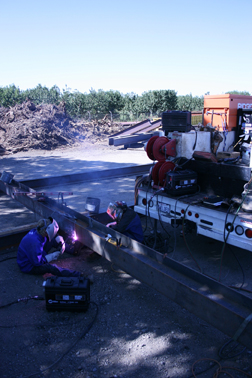
New Feeder Technology Improves Feeding Consistency

Setting Parameters Simplified Through Digital Meters, Wireless Remotes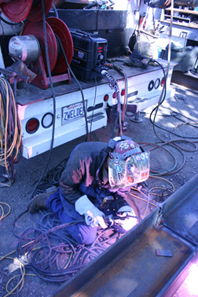
Specialized Flux-Cored Guns Take the Heat, Provide Optimal Comfort
robust design for working in hot and dusty outdoor applications.Handrails in Hell, Arizona
Handrails in Hell: Hot Az Hell Welding and Fabrication Puts Dura-Flux to the Test
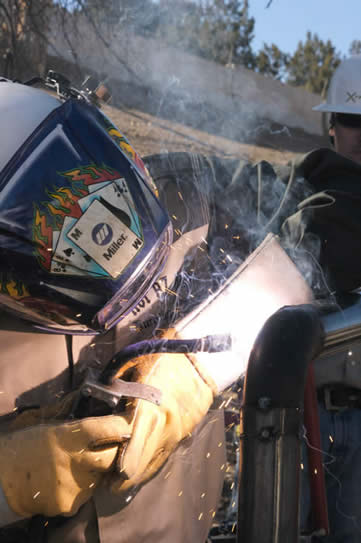
The key to success
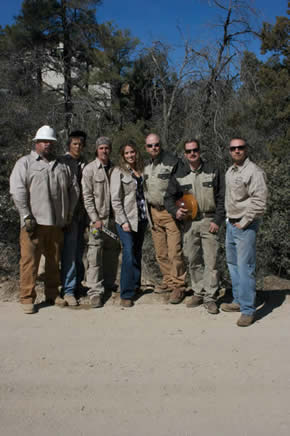
Everyone at Hot Az Hell Welding and Fabrication can perform multiple jobs, one of the secrets to their rapid growth and success since being founded in 2006.Focus on efficiency
Reliable equipment equals increased productivity
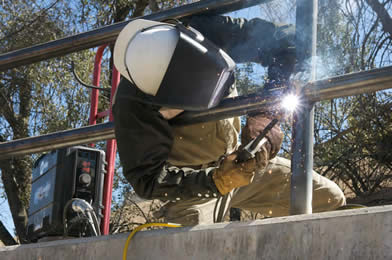
The Dura-Flux recently allowed Hot Az Hell Welding and Fabrication to install 200 linear feet of three-rail hand rails with only a single tip change – which was attributed to operator error.
Contractor increases productivity…
Jolson Welding Improves Productivity with New MIG, FCAW Equipment
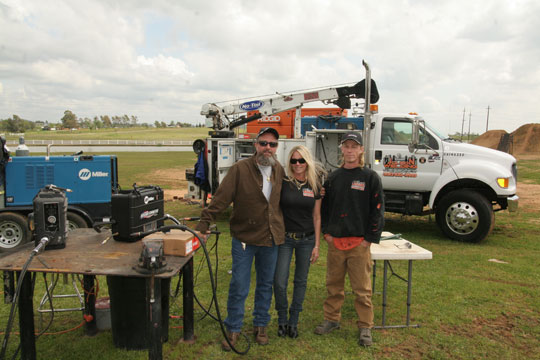
Making the Change
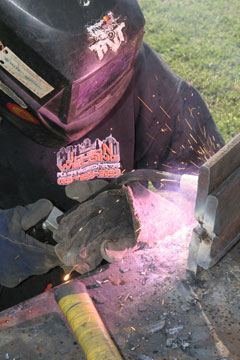
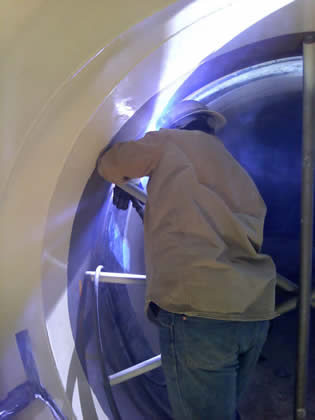
The result of the testing
The New Approach to Self-Shielded Welding
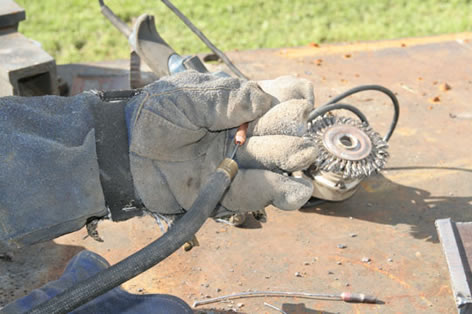
Gaining the Most Out of Gas-Shielded Welding

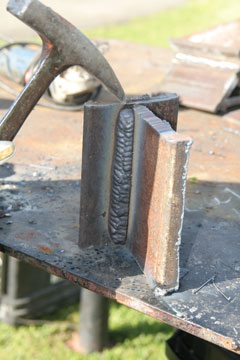
Tips For Avoiding Common Flux-Cored Problems & Improving Your FCAW Welds
Tips For Avoiding Common Flux-Cored Problems & Improving Your FCAW Welds
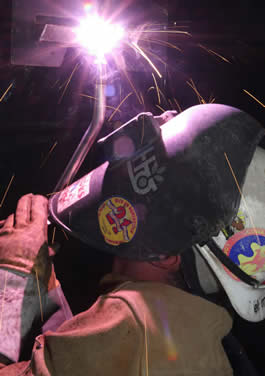
Tip One: Avoid Wire Feeding Problems
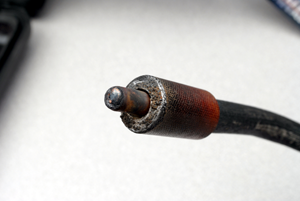

Tip Two: Stop Porosity and Worm Tracking
Tip Three: Eliminate Slag Inclusions
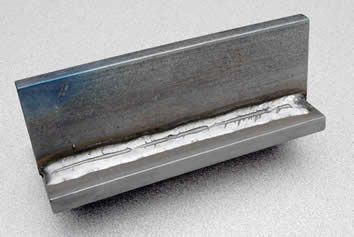
Tip Four: Prevent Undercutting and Lack of Fusion
Tip Five: Avoid Excessive Penetration or Lack of Penetration
Final Tips
Related Articles
Your FAQs About FCAW…
Your FAQs About FCAW-SS Problems Answered
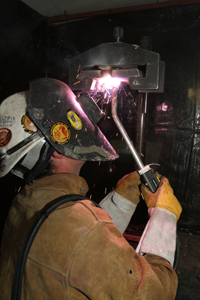
What are slag inclusions and how can I prevent them?
How can I prevent burnbacks?

Why does lack of fusion occur?
What are the causes of and solutions for bird-nesting?

What can I do to ensure I get the best joint penetration?
What can I do to prevent porosity?
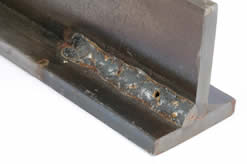
More FAQs?



